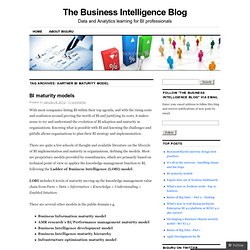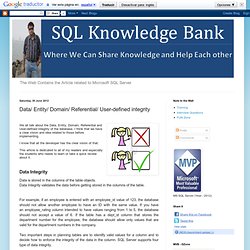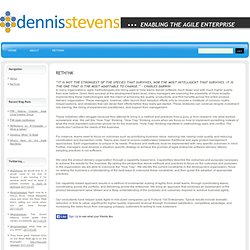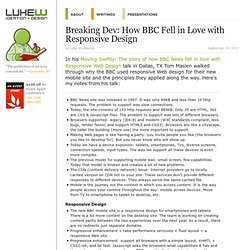

Questions I ask when reviewing a design by Jason Fried of Basecamp. I’ve been thinking more about how I review a design – both my own and someone else’s.

So over the past couple days I’ve been writing down every question I’ve been asking when I look at a design-in-progress. Some of these I say out loud, some just go through my head, some are in person, others are posted to Basecamp or Campfire. Tools for ideation and problem solving: Part 1. Back in the darkest days of my PhD, I started blogging extracts from the thesis as it was being written, particularly the literature review.

It helped keep me motivated when I was at a very low point, and seemed to be of interest to readers who were unlikely to read the whole 300-page PDF or indeed the publications. Possibly because of the amount of useful terms in the text making them very Google-able, these remain extremely popular posts on this blog. The Business Intelligence Blog. With most companies listing BI within their top agenda, and with the rising costs and confusion around proving the worth of BI and justifying its costs, it makes sense to try and understand the evolution of BI adoption and maturity in organizations.

Knowing what is possible with BI and knowing the challenges and pitfalls allows organizations to plan their BI strategy and implementation. There are quite a few schools of thought and available literature on the lifecycle of BI implementation and maturity in organizations, defining the models. Most are proprietary models provided by consultancies, which are primarily based on technical point of view or applies the knowledge management function to BI, following the Ladder of Business Intelligence (LOBI) model.
LOBI includes 6 levels of maturity moving up the knowledge management value chain from Facts > Data > Information > Knowledge > Understanding > Enabled Intuition. There are several other models in the public domain e.g. 1. 2.
Database Design. Designing for Trust. Designing Websites. Designing for Integration. Paul Nielsen : Data Architecture. From SQL Server 2008 Bible Appendix A.

Data Architecture is the overarching design of the database(s) and how they interact with other software. Data architecture is defined by the Information Architecture Principle and the six attributes by which every database can be measured. Information Architecture Principle For any complex endeavor, there is value in beginning with a common principle to drive designs, procedures, and decisions.
A credible principle is understandable, robust, complete, consistent, and stable. The Information Architecture Principle encompasses the three main areas of information management: database design and development, enterprise data center management, and business intelligence analysis. Unpacking this principle reveals several practical implications. Imagine A Pie Chart Stomping On An Infographic Forever.
Advertisement A certain category of design gaffes can be boiled down to violations of audience expectations. Websites that don’t work in Internet Explorer are a heck of a nasty surprise for users who, bless their souls, want the same Internet experience as everyone else. Websites that prevent copying, whether through careless text-as-image conversions or those wretched copyright pop-ups from the turn of the century, cripple a feature that works nearly everywhere else on the Internet. Avoiding this category of blunders is crucial to good design, which is why I am upset that one particular pitfall has been overlooked with extreme frequency.
Microsoft SQL Server Knowledge Bank: Data/ Entity/ Domain/ Referential/ User-defined integrity. We all talk about the Data, Entity, Domain, Referential and User-defined integrity of the database.

I think that we have a clear vision and idea related to those before implementing. Oracle to SQL. Dennis Stevens » ReTh!nk. “It is not the strongest of the species that survives, nor the most intelligent that survives.

It is the one that is the most adaptable to change.” – Charles Darwin In many organizations, agile methodologies are being used to help teams deliver software much faster and with much higher quality than ever before. Given their success at the development team level, many managers are exploring the possibility of more broadly implementing these methodologies with the intent of achieving the quality, productivity, and ROI benefits across the entire product-delivery organization. These managers, however, often launch their adoption efforts only to uncover a multitude of common myths, misperceptions, and obstacles that can derail their efforts before they really get started.
These obstacles can continue despite investment into training, the hiring of experienced practitioners, and support from management. We view the product delivery organization through a capability-based lens. Breaking Dev: How BBC Fell in Love with Responsive Design. In his Moving Swiftly: The story of how BBC News fell in love with Responsive Web Design talk in Dallas, TX Tom Maslen walked through why the BBC used responsive Web design for their new mobile site and the principles they applied along the way.

Here's my notes from his talk: BBC News site was released in 1997. It was only 94KB and less than 10 http requests. The problem to support was slow connections.Today, the site consists of 153 http requests and 889KB. Only 35 are HTML, 362 are CSS & Javascript files. Responsive Design. Writings on Digital Product Strategy & Design.